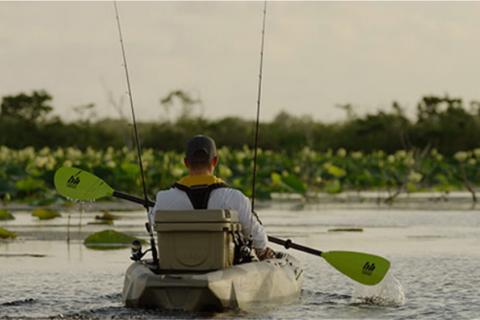
By Josh Workman, Cabela’s Pro Staff and Kayak Fishing Expert
There are a lot of questions you should be asking yourself while selecting a kayak. What waters will you fish? Will you be taking extended paddling trips or only fishing the weekends? How much gear do you want to be able to take?
Picking a Kayak Length
The length of your kayak should be determined by the kinds of waters you will be fishing. Shorter, 10- to 12-foot kayaks are great for inland lakes, ponds and slow-moving rivers. If you plan to fish in the ocean or larger bodies of water, you will want to consider a 12-foot or longer kayak. This extra length will help when battling any waves that you may encounter while you are out on the water.
Tip: Read the Basic Guide to kayaking for Beginners
Longer kayaks will be faster than shorter kayaks and will also add additional stability. Shorter kayaks will be more agile than the longer kayaks. So, if you are planning on taking a long trip, you will probably want a longer kayak with more speed. However, if you are fishing in a fast-paced river with obstacles, you might prefer a shorter kayak.
Consider the Kayak's Stability
When it comes to stability, there are a few things to look at. The wider a kayak is, the more stability you will have. The width will also provide more room in the kayak, making a long day on the water more comfortable. Also, the type of hull the kayak has will play a big role in how stable the kayak is. If stability is a high priority, look for a kayak that has a dual or tri hull. This helps displace water, adds stability, and it keeps you dry and inside the kayak.
Does the Kayak Have Built-in Rigging & Tackle Storage
Most modern fishing kayaks come with built-in storage, such as storage spaces with waterproof hatches, center consoles or front and rear deck spaces with gear-securing bungee cords. Many come with built-in rod holders to keep your extra rods handy. Many come with GearTracs or the ability to mount your own. With GearTracs, the kayak becomes customizable, letting you add gear ranging from extra rod holders to electronics to camera poles for your action camera.
What to Choose - Sit in or Sit on Kayak
There are two types, sit-on-top kayaks and sit-in. Sit-in kayaks keep your legs enclosed. While they do offer storage space, it is sometimes harder to access while in this style of kayak. Sit-in kayaks also do not offer the ability to stand and fish.
What Will be the Kayak's Propulsion?
There are three ways to propel a kayak through the water – paddling, pedaling or using an electric trolling motor. The traditional paddle is the most common form of propulsion.
The second form, the pedal drive, allows you to move the kayak through the water using pedals almost like those you would find on a bicycle. These are connected to a propeller or fins beneath the boat. Paddling is very common, however, pedal kayaks are on the rise because they free up your hands for fishing.
The third form of propulsion involves using a battery-powered trolling motor, just like one you would find on almost any fishing boat. Like the pedal drive, the trolling-motor option keeps your hands free so you can spend more time fishing. They also offer greater boat control.
The paddle-propelled kayak is the most common and affordable type of fishing kayak. They come in sit-on and sit-in styles, in many different lengths and widths. From fishing small inland lakes to ocean fishing, there’s a model for almost any fishing application.
Pedal kayaks are for the anglers who want to invest more up front and free up their hands for fishing. Pedal kayaks will also allow you to handle wind and fish structure easier than a paddle kayak.
Choosing a Kayak Paddle
When it comes to kayak paddles, the same amount of thought and research that goes into finding the right kayak should also go into getting the right paddle. Generally, you will want a light paddle that you will be able to paddle with all day. You also want a strong paddle, as you might get into a situation where you will need to push off stumps or the ground to help you maneuver, and you don’t want that paddle to break.
The Kayak's Weight & Material
Paddles are almost always made of lightweight materials like aluminum, carbon or strong plastics. You will want to choose the lightest paddle you can, especially if you plan to spend long periods of time on the water. The lighter the paddle – carbon being the lightest and most durable – the more you'll reduce fatigue and make the day more enjoyable on the water.
Kayak Paddle Length
The paddle you choose for your fishing kayak should be different than the one you choose for a recreational kayak. Most fishing kayaks are wider than recreational boats. Also, the seat in a fishing kayak is usually up higher than a regular kayak, and this places you farther away from the water. Both of these dimensions, wider sides and a higher seat, require you to choose a longer paddle in order to comfortably reach the water. Getting the right length will make your day on the water much more enjoyable.
- 3106 views

